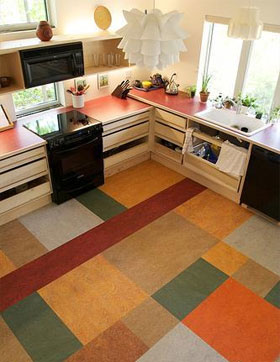
Linoleum kitchen flooring has numerous qualities that make it a desirable flooring product to use in the kitchen. Linoleum is available in a multitude of colors and patterns, is extremely durable, and like cork flooring, is one of the most environmentally friendly flooring products on the market today.
It does cost more than the vinyl which it is often mistaken for, and requires a special adhesive for installation, but don’t let that throw you off. Linoleum kitchen flooring may be just the right answer for your home.
What is Linoleum? Linoleum flooring is made of renewable resources like linseed oil, rosin, cork powder, wood floor, and pigments. It is totally recyclable, so forty years down the road when you might think about changing your floors, you can feel good knowing that your floor had a minimal impact on the environment. The color in linoleum goes all the way through, so there is no color fading over time. Linoleum can be used for a variety of projects including baseboards, trim, desktops, countertops, and of course, floors.
Linoleum is extremely durable and does not scratch or scuff, making it great for high traffic areas that see a lot of wear and tear. In fact, over time linoleum hardens which makes it even more durable to keep it looking beautiful no matter how much traffic it receives. It is widely used commercially because of the durability and ease of maintenance. Its natural bacterial resistant qualities make it great for use in rooms like the kitchen, bathroom, and the children’s rooms.
Advantages of linoleum kitchen flooring: Although linoleum costs slightly more than vinyl flooring, it will last much longer. This makes it much for cost effective long term. Because it is a natural product, linoleum is an excellent opportunity to “go green.” Design possibilities are enumerable thanks to the wide selection of colors and patterns available. Installing Your Linoleum Kitchen Floor Installing linoleum flooring is a lot like vinyl flooring except that you will use an adhesive made especially for linoleum. It can be installed over a smooth existing floor or sub-floor for maximum installation ease. If you are unsure whether your kitchen linoleum should be installed over the existing flooring, ask your contractor, flooring installer, or an expert at the home improvement store where you purchased your linoleum.
Caring for Your Linoleum Kitchen Floor Caring for linoleum flooring is not difficult. Sweeping up dirt and grit regularly will help to keep the dirt from being ground into the linoleum. Place rugs or mats at the entrances to try to alleviate some of the dirt, sand, and grit from the floors. Linoleum can be wiped clean with a damp mop.
From time to time you will want to polish your linoleum floors to keep them looking their best. Be sure to wipe up spills immediately as water runs the risk of loosening the linoleum. Use only plain water or a very mild detergent to damp mop. Be careful not to over wet linoleum floors.
Linoleum Could be the Answer You Seek! Linoleum kitchen flooring has come a long way since it was first patented in 1860. Thanks to the ever widening selection of colors and patterns, linoleum can be a wonderful choice for your kitchen floor without concern of your floor looking “too institutional.” Mix and match different colors with patterns to create that beautiful custom look that gives your kitchen character and interest.
With its durability, beauty, and ecologically sound engineering, linoleum can add that perfectly polished look to your kitchen for many years. With linoleum kitchen flooring you have the opportunity to create a beautiful, unique floor while doing something good for the environment. What could be better than that?





